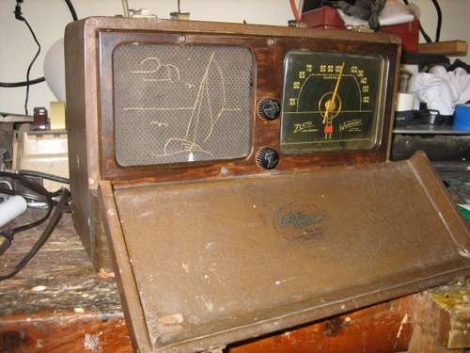
Instructables user [knife141] enjoys restoring vintage electronics in his spare time, especially old radios. AM radios tend to pique his curiosity the most, and in this tutorial, he discusses the restoration of an old radio from the early 1940s.
While people would likely assume that the vacuum tubes in a radio this old are the source of poor performance, he has found that most units he repairs suffer from bad capacitors. He says that the old electrolytic, paper, and wax caps used in these radios were never meant to last more than a few decades, let alone 70 years.
He always starts the process off by discharging the caps and replacing the power cord, both as a safety measure. He was pretty sure the capacitors were bad in this radio, so he swapped all of them out, regardless of condition. All of the internal wiring was then checked over, and any damaged cables were replaced or covered with heat shrink tubing.
With that done, he powered on the radio and was happy to find that the distortion he previously experienced was completely eliminated. With the electronics taken care of, he tackled the radio’s asbestos insulation by encapsulating it with varnish. Attention was then turned to the exterior, where he cleaned and buffed the leather, refinished the face plate, and polished the dial’s cloudy glass.
While it’s not exactly a hack, we always like seeing vintage electronics given new life, and we’re always cool with saving these sorts of things from rotting in a landfill.
















Bad caps are my guess often. Cheaper to replace as well…So I usually just replace all the caps.
mmm, I would say that actually it’s a hack! maybe not a complex one, but he improved its performance and thats the very definition of hacking :-)
NoX: Seriously. I mean, Richard Feynman used to do exactly this sort of thing when he was a kid, so I don’t think it falls to us to decide how awesome it is or isn’t.
Recapping can rescue modern equipment, too, like the surround-sound receiver one of my less thoughtful and better-paid neighbors dumped on the side of the road. It was manufactured in 2002, and fell prey to the capacitor plague; all it took was opening it up to see that the all of the large filter caps had swollen up and tried to go ‘pop’.
A couple of bucks and a bit of solder later, I’ve got a $150 stereo amp effectively for free. And the speakers he dumped with it aren’t bad, either! (I’d speak ill of him, if his foolishness hadn’t worked out to my benefit.)
No, don’t seal the asbestos in varnish. It’s probably made of asbestos and not plywood for a good reason and coating it in something which is not heatproof isn’t a good idea.
If it’s left alone inside the case it won’t be shedding any fibres and will be fine.
asbestos.
yikes. that thought wouldn’t even have crossed my mind. thanks- i will hopefully remember that next time i come across some old white heat resistive insulator material. i would have thought it was something like mica and added it to my collection..
As long as it isn’t a bad rectifier. You damn near need a gas mask when one of the old selenium rectifiers blows.
@tantris: Asbestos looks more grayish then white. And asbestos in itself isn’t that harmful, when you stark breaking it and it might start to cause problems. But in low quantities the risk is very low.
I would recommend installing an isolation transformer on the main line — these old sets tend to have a hot chassis or something similarly dangerous.
@asheets
It was mentioned that he changed the power cord.
When I replace the power cord on old radios I use a polarized cord (with polarized plug) and attach the wide blade of the plug (the neutral side) to the chassis. Now if only people would wire up their outlets correctly!
Back in the ’70s a typical sign of a lightning voltage spike hitting a TV that came in for repair was seeing those film caps popped out like a streamer at New Years Eve – the oil would vaporize and whooosh!
I’m not a bit surprised those old capacitors are toast.
@ Aaron Never seem a SMPS in a stereo, or seen regular supplies fail like above.
@ Ren I trust my life to 3 prong but not that mm of wider prong on those stupid plugs. If you want to do it right get rid of the Edison socket and everything non IEC. Exposed pins on insertion, how dumb. Wide blades were created for that dumb bulb socket. Have you heard the story of the farmer when REMC came to wire him up and forget to bring bulbs. When they returned he had screwed corncobs into the sockets to keep the juice from running out!
The cord on many of those battery/AC sets had a resistor wire in the cord to drop the AC to the tube string of heaters. Replace it with a regular cord and poof!
The asbestos should be removed now that its varnished and a piece of metal used instead to keep from heating case and marring the finish.
Correct this being a AC/DC portable, chance are the AV neutral is connect to the chassis. Even when plugged into properly wire receptacle, many aren’t, an isolation transformer is till a good idea when working with these radio. Stating the obvious an unknown problem could lead to a hot chassis. One can work without an isolation transformer, if they are aware how to work safely. In addition to an isolation transformer, a Variac transformer is good idea. To bring up the voltage slowly when powering an older radio for the first time in years. Personally I’d think it would be fun to build battery packs to operate this glow in the dark radio portable.